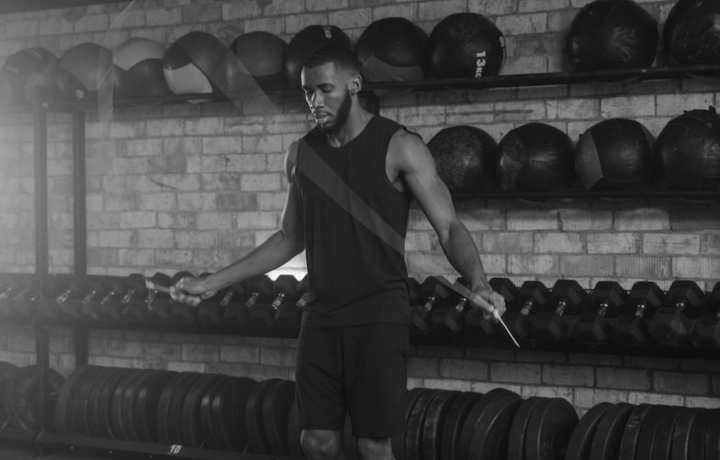Exercise
Jumping Jack

Jumping Jack
How to Perform
- Stand upright with your feet together and arms at your sides, maintaining a neutral spine and engaged core.
- Jump your feet outward to slightly wider than shoulder-width apart while simultaneously raising your arms out and up overhead.
- As you raise your arms, keep your shoulders relaxed away from your ears and maintain a slight bend in your elbows to avoid hyperextension.
- Breathe out as you jump your feet apart and raise your arms to help engage your core.
- Jump your feet back together while simultaneously lowering your arms back to your sides in one fluid motion.
- Breathe in as you return to the starting position, keeping your knees slightly bent to absorb the impact.
- Land softly on the balls of your feet before rolling to your heels, maintaining proper alignment through your ankles, knees, and hips.
- Continue the movement at a consistent pace, focusing on coordination and controlled landings rather than speed.
Important information
- Keep your core engaged throughout the entire movement to protect your lower back and maintain stability.
- If you're a beginner or have joint issues, start with a modified version by stepping out instead of jumping.
- Maintain an upright posture with your chest lifted and shoulders back, avoiding leaning forward during the exercise.
- For increased intensity, speed up the pace or add a small squat when your feet are in the wide position.

Jumping Jack
Exercise Details
Primary Muscles
Mechanic
Built for progress
Take the guesswork out of training
Create personalized AI-powered workout plans that evolve with you. Train smarter, track every rep and keep moving forward, one workout at a time.






The jumping jack stands as one of fitness's most recognizable and versatile movements, making it perfect for beginners while still delivering results for experienced exercisers. This classic cardio exercise elevates your heart rate quickly while engaging multiple muscle groups simultaneously, proving that sometimes the simplest movements yield the most impressive benefits.
As a cornerstone of cardio training, jumping jacks efficiently burn calories while improving circulation and respiratory function. Their rhythmic nature helps establish a steady breathing pattern, making them particularly valuable for those new to fitness who are still developing their cardio base. The exercise's low-impact variation—keeping feet closer to the ground with smaller movements—offers an accessible entry point for beginners concerned about joint stress.
Jumping jacks shine brilliantly within HIIT protocols, warm-up routines, and cool-down sequences alike. In high-intensity interval training, they serve as an excellent spike exercise that quickly elevates heart rate between strength movements. When incorporated into warm-ups, jumping jacks prepare the body by increasing core temperature, enhancing joint mobility, and priming the nervous system for the workout ahead. During cool-downs, a gentler execution helps gradually return the heart rate to resting levels while maintaining blood flow to working muscles.
The beauty of jumping jacks lies in their dual contribution to cardiovascular health and muscular endurance. Regular incorporation helps strengthen the heart muscle while improving oxygen delivery throughout the body. Meanwhile, the repetitive nature challenges muscular staying power, particularly in the shoulders, calves, and core stabilizers that must work continuously throughout the movement.
Research suggests that simple, accessible exercises like jumping jacks promote better adherence to fitness routines, especially among beginners. Their familiarity removes barriers to entry while their effectiveness ensures continued results. Whether used as a standalone conditioning exercise or integrated into a comprehensive fitness program, jumping jacks deliver impressive cardiovascular benefits without requiring complex instruction or specialized equipment.
FAQ - Jumping Jack
Jumping jacks primarily engage your deltoids, quadriceps, hip flexors, and calves. Your core muscles also activate throughout the movement to maintain stability, making it a surprisingly comprehensive full-body exercise.
Standard jumping jacks can place stress on knees, but most people with healthy joints can perform them safely. If you have knee concerns, try the low-impact variation by stepping side to side rather than jumping, or perform them on a softer surface like a yoga mat.
For cardiovascular benefits, aim for 3-4 sets of 30-50 repetitions with brief rest periods between sets. In HIIT workouts, try 20-30 seconds of jumping jacks at maximum effort followed by 10-15 seconds of rest, repeated for 4-8 rounds.
The most common errors include landing heavily on your heels, allowing your shoulders to hunch forward, and not fully extending your arms overhead. Focus on landing softly through your midfoot, maintaining proper posture, and completing the full range of motion with each repetition.
Increase intensity by adding a squat at the bottom position, incorporating cross-jacks (crossing arms and legs), or wearing light wrist/ankle weights. You can also try plyo jacks where you jump higher with more explosive power, or integrate them into Tabata intervals for maximum cardiovascular challenge.






